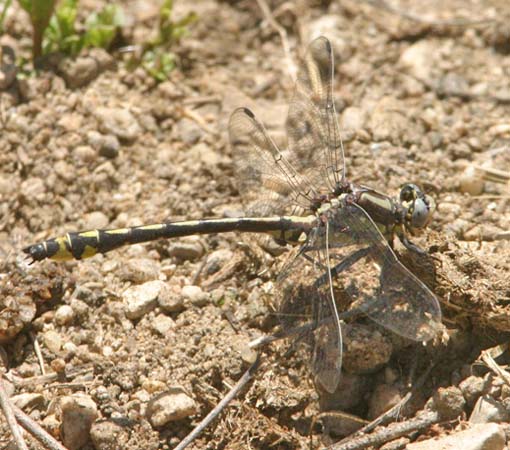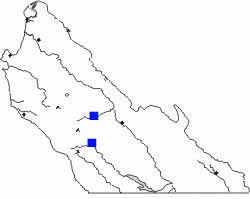| |
|
|
PACIFIC
CLUBTAIL
Gomphus
kurilis
|
|
Pacific Clubtail is a denizen of rushing
rivers in the mountains. It is an early flier, present only the spring,
when males sit on rocks in the streams and chase females, or defend
against other males, with short, bounding flights.
|
|
|
 |
Pacific Clubtail is named for the expanded
tip of the abdomen, most exaggerated in males (above & left). The
abdomen has a complex pattern of black-and-yellow, but the pattern is
quite different than Bison
Snaketail which can share the same habitat in spring. Also, unlike
the snaketail, the thorax is essentially the same color as the abdomen
– a dull yellow, cream, or pale greenish-yellow – and not a contrasting
bright green. Further, the thorax has two dorsolateral stripes, not
just one, and a broad slashing side stripe. The eyes are blue and are
perhaps the most striking part of the front half of this ode. As in all
our gomphids, the wings are clear. |
|
|
Photos (above) 12
May 2007 North fork San Antonio River
Photo (below) 29 Apr 2007 North fork San Antonio River
|
|
|
|
Until 2007, there was only one record of
Pacific Clubtail in Monterey County. A specimen in the Bohart
collection at U.C. Davis was collected along the Arroyo Seco River on
27 May 1974, possibly by Robert M. Bohart himself.
On 29 Apr 2007, Don Roberson found the
Pacific Clubtail shown above on the upper San Antonio River. It was
sharing a rock with a Bullfrog and, concerned that the frog would eat
the ode before it could be documented, Roberson splashed right into the
river, boots and all, to snap this shot. Both clubtail and frog
departed without further ado. Up to 8 Pacific Clubtails were found
along this same stretch of river the following weekend.
|
|
|
An interesting feature of Pacific Clubtail
is that the younger individuals are a lot brighter in color than the
full adults. The immature males (right and below) are bright
school-crossing yellow, unlike the much more subdued colors of the
territorial males shown above. All the young clubtails shown (right and
below) were along trails through the woods, and not at territorial
breeding spots along a nearby creek. Females also spend almost all
their time away from the streams and rivers.
Photo (right)
15 Apr 2007 Gibson Ranch Co. Park, Sacramento Co.
Photo (below) 15 Apr 2007 Miners Ravine Reserve, Placer Co.
|
|
|
|
|
|
 The map shows the currently known location
for Pacific Clubtail in MTY: along the Arroyo Seco and upper San
Antonio rivers. It likely occurs on many (all?) of the major streams
running out of the Santa Lucias. This species occurs along rivers and
on lakes throughout the mountains of both the Sierran and Coast ranges
of northern California. MTY is its southernmost known locale in the
Coast Range [it occurs south to Madera Co. in the Sierra Nevada]. The map shows the currently known location
for Pacific Clubtail in MTY: along the Arroyo Seco and upper San
Antonio rivers. It likely occurs on many (all?) of the major streams
running out of the Santa Lucias. This species occurs along rivers and
on lakes throughout the mountains of both the Sierran and Coast ranges
of northern California. MTY is its southernmost known locale in the
Coast Range [it occurs south to Madera Co. in the Sierra Nevada].
Pacific Clubtail has an early flight season,
ranging from April through July (Manolis 2003). The known dates in MTY
are 29 Apr–13 May.
|
|
|
Literature cited:
- Manolis, T. 2003. Dragonflies and Damselflies of
California. Univ. of
Calif.
Press, Berkeley.
Web resources:
Major identification web sites with much information on California
odes include:
For sites with excellent photos to compare for identification or to
simply
enjoy, see:
Many of these sites have links to other useful pages. Kathy Biggs's
site
is particularly useful in her selection of links. |
|
All photos © Don Roberson 2007
TOP
|
|
|
Page created 8 Mar 2007,
revised 16 May 2007
|
|
|
|
|
